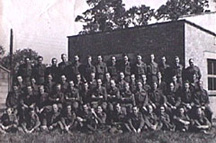|
 |
 |
 |
 |
 |
 |
 |
 |
 |
 |
 |
 |
 |
 |
 |
 |
 |
 |
 |
 |
 |
|
 |
 |
SPECIAL OPERATIONS EXECUTIVE
Agents equipment |
|
|
|
|
|
|
|
|
 |
|
|
|
|
Pointing out the CO's office that is practically unaltered from the original. This office housed Capt. Castleman and his secretary, Aubrey Green.
The only military type parades was that of "pay parade". At the command "pay parade" from WO11, Bert Norman, we queued outside the CO's office and marched individually to collect our pay from Capt. Castleman with a salute in the usual military fashion.
Administration tasks, which included preparing pay and movement of personnel, was carried out at the Whaddon station. |
|
 |
 |
|
 |
|
|
|
 |
|
 |
|
|
|
Click icon to listen to audio of the text right |
|
|
|
|
|
|
 |
Indicating the original position of an outside door that lead to a separate building which was used for testing and calibrating the manufactured items. About six members of staff worked there, headed by Ted Turner.
This small building no longer exists. It has been replaced by (on right) a large agricultural building. |
|
|
|
|
|
|
|
|
|
 |
|
 |
|
 |
 |
|
|
|
|
|
|
|
|
|
|
|
 |
Click icon to listen to audio of text above |
|
|
|
|
|
|
|
 |
|
|
|
|
Between myself and the blue door was a standby diesel generator, housed in a brick building (now removed). In 1944, this brick enclosure formed the background for a group photograph of the manufacturing staff, which is to be shown next. |
|
|
 |
 |
|
|
 |
 |
|
|
|
|
|
|
|
|
|
|
|
|
|
|
|
 |
Click icon to listen to audio of text above |
|
|
|
|
 |
|
|
|
|
 |
|
Click icon to listen to audio of text below left |
|
|
 |
These are mainly 'family men', some more than fifty years of age, certainly not front line material. There was a predominance of professional people, mainly headmasters, teachers, businessmen, office workers and some commandeered from G.P.O. telephones. Small elements of younger fit men were 'short stay' members whom seldom, if ever, returned to the workshop.
Note the separate testing department on the left of the photo and the tall elm trees beyond the ridge of the main building. |
|
|
|
|
|
|
|
|
|
|
|
|
 |
|
 |
|
|
 |
We had no knowledge of the overall set-up and trying to find out was not encouraged. Only seeing television programmes many years later was I able to identify our links with other organisations. Suffice to say that we were formely known as SSU1 and later became SCU1 (Special Communication Unit). |
|
|
 |
|
|
|
|
|
|
|
|
|
|
|
|
|
|
|
 |
 |
|
|
 |
|
|
|
|
|
|
|
Back to Top |
|
|
|
|
|
|
|




